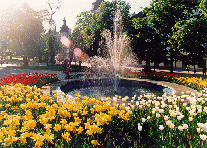 Plzen Guide: Through the Streets and Parks
Plzen Guide: Through the Streets and Parks Plzen Guide: Through the Streets and Parks
Plzen Guide: Through the Streets and ParksThe period of Enlightenment and the following years until the beginning of 20th century, were revolutionary times for the town.

The Josephine reforms had also hit Plzen. Rebuilding the abolished Dominican nuns' convent resulted in a grand-designed lyceum - a centre of civilization and of a patriotic revival. It kept its cultural tradition until now as it became a State Science Library.
The demolition of the walls was so far the biggest intervention to the town. It helped the town to expand beyond its former size. The number of new houses increased, new cloister was built where the walls had stood. This reconstruction affected the whole fortification system which had to be teared down. Only fragments and one of four Baroque corner bastions which general Lacron used in 1646 to fortify the town remains. New areas gave place to town parks.
With prosperous industry and a higher living standard of increasing number of inhabitants, there are also changes in character of a building scheme. At times many architecturally valuable objects had to give way to the new buildings.
The period of neo-historical styles left town with lyceum, built in the style of English Romantic Gothic, neo-Renaissance building of a theatre, the town museum and many blocks of flats.
Especially important is a work of the architect Rudolf Stech who enriched Plzen with two spires of the largest synagogue in Bohemia. To this day we admire houses decorated with graffiti by famous Czech painter Mikolas Ales, who co-operated with Stech.
 and
Czech
and
Czech  versions.
versions.
Copyright © 2002 City of Plzen. All Rights Reserved.